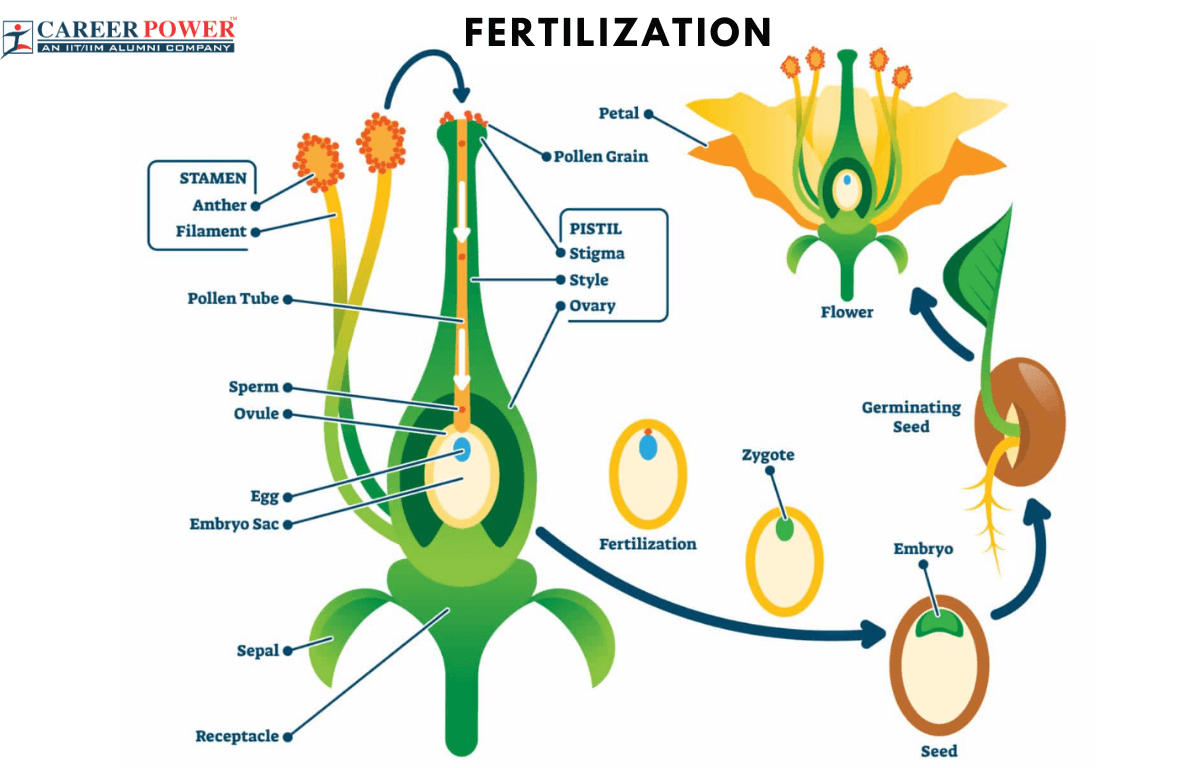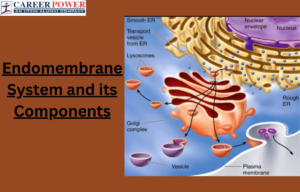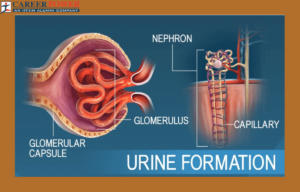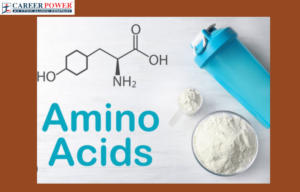Table of Contents
Fertilization is one of the most important topics of the chapter “How do organisms reproduce” from the class 10th Biology section. Hope this article will help you to understand the process of fertilization more easily. Plants reproduce both in sexual and asexual modes. The flowers are the most important part of the plant as they not only make the plant look attractive but also help in the reproduction process, as sexual reproduction in plants takes place inside the flower itself. Sexual reproduction in plants involves the fusion of male and female reproductive cells to produce offspring. In most plants, the male gamete (sperm) is contained in pollen, while the female gamete (egg) is located in the ovule.
The Reproduction process in plants starts with Pollination, where pollination is the transfer of pollens from the male reproductive part (Anther of a stamen) to the female reproductive part (Stigma of a carpel). This process is further carried out as Fertilization. Once the pollen reaches the stigma of a flower, it travels down to the ovary where fertilization occurs, resulting in the formation of seeds. Fertilization allows genetic diversity and adaptation in plant populations.
Definition of Fertilization in Plants
After pollen grains fall into the stigma, the next step is Fertilization. Fertilization is a biological process in which male and female reproductive cells, called Gametes, fuses to form new offsprings. This fusion of gametes combines the genetic material of both parents, which helps the new offspring attain genetic material from both parents. In most plants, pollens from the male reproductive part (Anther of Stamen) carry the male gamete to the female reproductive part (Stigma of Carpel), where fertilization occurs. This process of fertilization leads to the formation of a Zygote, which eventually develops into a new plant embryo.
Process of Fertilization in Plants
In plants fertilization is the process in which both male and female reproductive structures come together to combine their genetic material and form a Zygote. This process is mostly found in flowering plants or we can call them Angiosperms. Fertilization in plants involves several steps, and all of those steps are mentioned below:
Pollination
In Pollination, pollen grains (the male gametes) are transferred from Anther (male reproductive part) to the Stigma (female reproductive part) of a flower. The process of pollination can occur through various means such as wind, water, insects, birds, or other animals.
Germination of Pollen
Germination of pollen refers to the process where pollen grains germinate and forms a pollen tube after landing on the stigma (the female reproductive part) of a flower. This pollen tube allows the male gamete (sperm cells) to travel to the ovules within the ovary for fertilization. The pollen tube grows down the style towards the Ovary. This Pollen tube contains two sperm nuclei.
Double Fertilization
Double fertilization is a unique process in flowering plants called Angiosperms, where two fertilizing events takes place within the ovules. One sperm fertilizes the egg cell and leads to the formation of a zygote. This newly formed zygote then develops into the embryo. The pollen tube reaches the ovary and enters the tiny opening called the micropyle. Within the ovule, there are two female gametes: The egg cell and two polar nuclei.
Syngamy
Syngamy is the first and fundamental step of fertilization. In this event, the fusion or union of two male and female gametes (reproductive cells) takes place, which leads to the formation of a Zygote. This zygote soon develops into an Embryo.
Triple fusion
This process occurs during double fertilization in angiosperms. The second sperm nucleus fuses with the two polar nuclei, which results in the formation of a triploid nucleus. This process initiates in the development of endosperm. The endosperm is a tissue that provides nourishment to the growing Embryo.
Embryo Development
The embryo development in plants refers to the process by which a fertilized ovule develops into an embryonic plant or a Zygote. The zygote formed by the fusion of male and female gametes undergoes several stages of cell division, and differentiation, which leads to the development of various plant tissues and structures. As the embryo grows, it forms the primary root, shoot, and cotyledons, which are very important for the establishment of a new plant.
Seed Formation
The ovule further develops a tough coat around it and is gradually converted into a seed (containing a baby plant). The small baby seed consists of an endosperm, embryo, and seed coat. In fact, all the eggs in the ovule present in the ovary of the flower get fertilized by the male gametes from pollen grains and grow to become a seed.
Seed
A seed is the reproductive unit of the plant (which can be used to grow s new plant). The seed contains an embryo or a baby plant and food for the baby plant. The part of the baby plant in seed which further develops into a shoot with leaves is called Plumule and part the part which develops into the roots is called Cotyledon. Some examples of seeds are wheat grains, gram (chana), corn, peas, and beans. The baby plant present inside the seeds is in an inactive state (which can also be denoted as a dormant state). When the seed gets suitable conditions like water, air, and warmth, it germinates and a new plant grows out of the seed. Through this process, the parent plant reproduces more plants like itself by forming seeds through flowers.
Fruit Development
The ovary around the fertilized ovules develops into a fruit (with seeds inside it). The other parts of a flower such as petals, sepals, stamen, stigma, and style dry up and fall off. Only the ovary is left behind. So at the place on the plant where we had a flower originally, we now have a fruit (which is the ovary of a flower containing seeds). This developed ovary or fruit protects the seed and assets in its dispersal. Some of the fruits are sweet, soft, and juicy like oranges and mangoes. But some fruits are hard, dry, and woody like peanuts, almonds, etc.
Seed Dispersal
Seed dispersal is a very important phase in the plant’s life cycle, as it ensures the spread of seeds away from the parent plant. Once the seeds are matured the fruit may split, and animals might eat those fruits and disperse the seeds. This seed dispersal mechanism increases the chances of finding suitable conditions for the germination and growth of the seed. There are various methods of seed dispersal such as Water dispersal, Animal dispersal, Wind dispersal, etc, to help in the survival of offspring.
Seed Germination
Seed Germination is the process by which a seed transforms into a young plant. Germination takes place when the conditions are favorable such as an adequate amount of moisture, temperature, and light. This process starts with the absorption of water, which activates the enzymes. With the help of these enzymes, the growth of the plant embryo starts and a new plant begins to emerge from the seeds.
The whole fertilization process ensures the continuation of plant species by facilitating the exchange of genetic materials and the development of new offspring.
Types of Fertilization in Plants
Fertilization is mainly of three types: Progamy, Chalazogamy, and Mesogamy. These different types of fertilization allow plants to adapt to various environmental conditions and ensure successful reproduction. Each type of fertilization has evolved to suit different plant species. Now let us discuss all three types of fertilization in brief.
Porogamy
Porogamy refers to the process in which the male and female reproductive organs of a plant mature at the same time, Which allows the possibility of self-pollination. This can be advantageous in environments where pollinators are not present or are present in a very small amount. Porogamy can also be explained as a strategy used by some plants to increase their chances of successful reproduction.
Chalazogamy
In Chalazmogamy, fertilization takes place through the Chalaza, which is a basal part of Ovules. In normal fertilization, pollen travels down the style and enters the ovules through the micropyle. But in chalazogamy, the pollen tube enters the ovules through the chalaza, which leads to unique genetic combinations and sometimes results in abnormal seed development. Chalazogamy is very rare and takes place in certain species as an alternative reproduction.
Mesogamy
Mesogamy refers to the type of self-fertilization, in which pollens are transferred from the Anther (male reproductive organ) of the flower to the Stigma (female reproductive organ) of another flower within the same plant. Mesogamy promotes genetic diversity, as it involves the mixing of genetic material from two different flowers on the same plant.

 Endomembrane System - All the Organelle ...
Endomembrane System - All the Organelle ...
 Urine Formation, Function of Tubules, Os...
Urine Formation, Function of Tubules, Os...
 Amino Acids - List, Properties, Function...
Amino Acids - List, Properties, Function...
